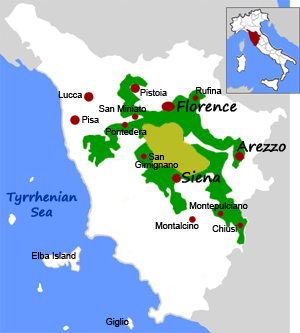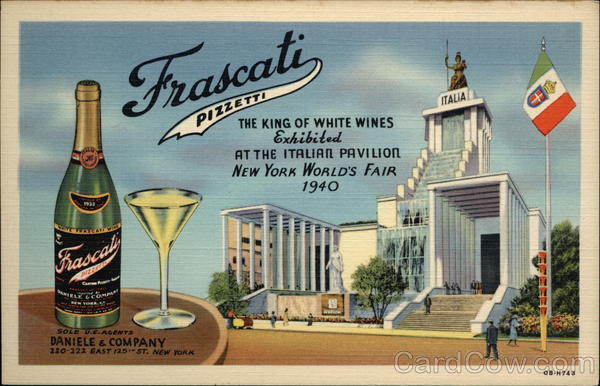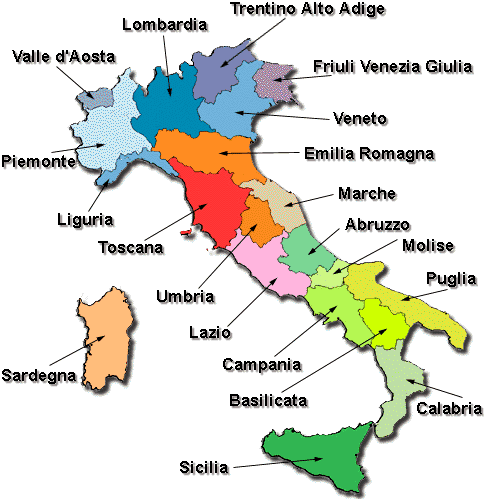Sorry about the lack of updates lately everyone! My internet has been pretty atrocious all week, and so getting a post written and uploaded has been impossible. To make up for it, today's wine post will be a two-for-one. I'll be covering 2 different regions of Italy, one very well-known for wine and the other almost entirely ignored: Toscana and Lazio.
We'll start with Toscana, better known as Tuscany in English. In many ways, Toscana is responsible for the entire modern Italian wine industry. Though Italy has always been a large producer of wine--and a small portion of it very well regarded--for about the first 3/4 of the 20th century most Italian wine was seen as substandard much too old-fashioned. Grapes were grown using out-of-date agricultural techniques, wines were made using traditional methods for no reason other than tradition, and the overwhelming majority of Italian wine exported from Italy was something like this:
 |
| Cool bottle, but the contents may as well be vinegar |
All of this began to change with the emergence of the so-called "Super Tuscans" onto the scene in the early 1970s. The regulations developed by the Italian government in the 1960s (the IGT/DOC/DOCG hierarchy that I discussed in my last wine post) in many ways cemented bad wine making processes. Chianti, for example, was required to be made with at least 10% white grapes, which made it very fruity and drinkable, but closer to juice than a sophisticated wine for the international market. The "Super Tuscans" were wines produced with more modern techniques, and often including grape varieties not native to Italy, such as Cabernet and Syrah. They didn't qualify for the much coveted governmental designations, but they were
good. And priced accordingly, of course.
 |
| The very first Super Tuscan, Tignanello, with 1971 being the first vintage. A bottle of the most recent vintage (2012) will run you about $70-80 in the US. |
The successes of the Super Tuscans, which were really being seen by the early 1980s, completely changed the Italian wine industry. Rather than adhere to the strict government regulations, wine producers began to produce the best wine possible regardless of technique or grape varietal. By the 90s they actually managed to convince the government to change these regulations, creating the IGT designation which allowed for much more variety in the production of a region's wine. Though the DOC/DOCG rules are still somewhat problematic, particularly in Toscana, Italy now produces a wide variety of wines that can stand up on the international market--thanks to the Super Tuscans of the 70s and 80s.
 |
| The staggering variety of Tuscan DOCs and DOCGs |
Along with Piemonte and the Veneto, Toscana is one of the 3 great wine producing regions of Italy and, as you can see from the above map, there is quite a wide variety of wine produced there. While a lot of this isn't seen in the US, much of what does make it across the pond stands among the very best wine in the world. I obviously won't be going over all or even most of these, but I'll touch on a few of the most famous and highly regarded. Let's start at the top: Brunello di Montalcino.
 |
| The city of Montalcino |
"Brunello" actually refers to a specific variety of grape, but after extensive testing it was determined that this supposedly unique grape was actually Sangiovese, a grape used in most of the red wines in central Italy. There are references to the wine going all the way back to the 14th century, though wine in those days would have been very different from what we enjoy today. In order to qualify as DOCG Brunello, the wine has to spend a minimum of 2 years in oak. Brunello is regarded as one of Italy's greatest wines (much like Barolo, which I'll be discussing in a future post), and prices naturally follow. A bottle will set you back around $100 if it's from a quality producer. As for what to expect, Brunello tends to be fairly fruit-forward, like many new world wines. Be warned however; the tannin in this wine (that sort of mouth-puckering quality red wines have) mean that you should probably be drinking vintages that are at least 10 years old; in fact, these wines can stand up to decades of aging. Moving on to a less well-known but no less impressive Tuscan wine: Vino Nobile di Montepulciano.
 |
| The city of Montepulciano |
Like Brunello, Vino Nobile is made primarily from the Sangiovese grape, though up to 30% can come from other local sources. In terms of character it's quite similar to Brunello, though a little less rich and a little more earthy. It's also much, much more affordable: if you can track down a bottle it should run you around $20. It also requires (and can tolerate) less aging than Brunello; you probably want to drink it within 15 years or so. Last but certainly not least are Chianti and Chianti Classico.
 |
| Fava beans optional |
Chianti is surely the best known Tuscan wine, and as I mentioned above it was also responsible for the poor international perception of Italian wines. "Chianti" actually refers to a specific region of Toscana that was first formally delineated in the early 18th century by the Duke of Florence, Cosimo III de'Medici.
 |
| I'm speculating, but it looks like old Cosimo may have been a victim of the inbreeding of European nobles... |
The area he specified is what is now the Chianti "Classico" area. The popularity of Chianti led the Italian government to make some...questionable decisions in the 1960s, hugely expanding the traditional zone and elevating the entirety of it to DOCG status, a designation that wasn't really warranted. As a result, lots of low quality wines got to call themselves by a prestigious title, and Chianti's once-great reputation became less and less valuable. While this continues to be a problem, if you stick to Chianti Classico you get something closer to what caused all the fuss in the first place.
 |
| Green is the Chianti region, and the yellow is Chianti Classico |
Any liquor store in the US will have Chianti, and most likely several bottles to choose from. Like Brunello and Vino Nobile, Chianti is made primarily from the Sangiovese grape. It tends to be a bit less tannic than either of the above, and has some spice (like cinnamon and clove) to it, as well as red fruits like cherry and raspberry. If you're looking for something to go with your spaghetti, this is your wine. High acidity and its balanced nature makes Chianti perfect for Italian food. You can find Chianti all over the price spectrum, but I think that the $15-20 range will get you the most bang for your buck. I would also recommend sticking to Chianti Classico; it's not that there aren't perfectly nice non-Classico bottles, but if you stick to the Classico you'll get a better idea of the unique properties of the region. You're likely to see a huge variety of labels, but I like Ruffino quite a bit. You can identify the non-Classico variety by the image of a medieval knight on the label, but the Classico looks like this:

If you want to see what central Italian red wine is like, Chianti Classico is the perfect introduction. But now, we move from one of Italy's best-known regions to one of the least: Lazio. The Italicized version of ancient Latium, Lazio is the region in central Italy just south of Toscana. Home to lots of fascinating history (Rome is here, after all), it's not a region particularly known for its wine. Much of the wine here is produced by large factories, and the quality tends to be on the low side. There are some gems to be found though, at least if you like white wine. The geography and climate make the region better suited for whites than reds, but most don't make it out of the country. If you happen to see some wine from Lazio in the US, it's probably Frascati.
 |
| Though I've never heard it called "the king of white wines" before, it is quite tasty |
Dry, refreshing, and easy-drinking, Frascati is produced in the hills just south of Rome. It's made from Malvasia and/or Trebbiano grapes, and is generally a very pale yellow color. You can expect flavors of orchard fruits like apple and pear, and some minerality as well. And the best part: you shouldn't have to pay more than $10 for a bottle. You generally want to buy the newest vintage that you can find, as this isn't a wine meant for long aging. This wine is for drinking, not for thinking.
That should do it for this update. Assuming my internet holds up, I hope to be posting more regularly moving forward. Thanks for reading!











No comments:
Post a Comment